Business > AS Mark Scheme > GCE New Business H431/01: Operating in a local business environment Advanced GCE Mark Scheme for Aut (All)
GCE New Business H431/01: Operating in a local business environment Advanced GCE Mark Scheme for Autumn 2021
Document Content and Description Below
Oxford Cambridge and RSA Examinations GCE New Business H431/01: Operating in a local business environment Advanced GCE Mark Scheme for Autumn 2021Oxford Cambridge and RSA Examinations OCR (Oxfor... d Cambridge and RSA) is a leading UK awarding body, providing a wide range of qualifications to meet the needs of candidates of all ages and abilities. OCR qualifications include AS/A Levels, Diplomas, GCSEs, Cambridge Nationals, Cambridge Technicals, Functional Skills, Key Skills, Entry Level qualifications, NVQs and vocational qualifications in areas such as IT, business, languages, teaching/training, administration and secretarial skills. It is also responsible for developing new specifications to meet national requirements and the needs of students and teachers. OCR is a not-for-profit organisation; any surplus made is invested back into the establishment to help towards the development of qualifications and support, which keep pace with the changing needs of today’s society. This mark scheme is published as an aid to teachers and students, to indicate the requirements of the examination. It shows the basis on which marks were awarded by examiners. It does not indicate the details of the discussions which took place at an examiners’ meeting before marking commenced. All examiners are instructed that alternative correct answers and unexpected approaches in candidates’ scripts must be given marks that fairly reflect the relevant knowledge and skills demonstrated. Mark schemes should be read in conjunction with the published question papers and the report on the examination. © OCR 2021H431/01 Mark Scheme October 2021 2 1. Annotations Blank page Tick Cross Highlighting tool Not answered question Own Figure Rule Benefit of Doubt Repeat Noted but no credit given Too vague/No use of context Unclear Knowledge Application of knowledge and understandingH431/01 Mark Scheme October 2021 3 Analysis Developed Analysis Evaluation Effective evaluationH431/01 Mark Scheme October 2021 4 EVERY PAGE, INCLUDING BLANK PAGES (use the BP annotation), MUST HAVE SOME ANNOTATION Please ensure that, wherever possible, annotations are placed in the margins and not over the candidate’s answer. This makes it very difficult to read when the paper is printed out in black & white. [Questions 1-15 should ONLY be annotated with ticks, crosses or NAQ. Question 18(a) should be annotated with ticks, crosses, BOD, REP, TV, OFR, NAQ or ?. The number of ticks plus OFR MUST match the final mark awarded for that question. Ticks MUST NOT be used in Questions 16-17 & 18(b)-20.] IT IS VITAL THAT YOU SHOW AS MUCH ANNOTATION ON EACH PAGE AS POSSIBLE. IN PARTICULAR, WHERE AOs ARE REACHED, SO THAT YOUR TEAM LEADER CAN LOOK TO AGREE WITH YOUR FINAL MARK. Subject-specific Marking Instructions INTRODUCTION Your first task as an Examiner is to become thoroughly familiar with the material on which the examination depends. This material includes: • the specification, especially the assessment objectives • the question paper and its rubrics • the mark scheme. You should ensure that you have copies of these materials. You should ensure also that you are familiar with the administrative procedures related to the marking process. These are set out in the OCR booklet Instructions for Examiners. If you are examining for the first time, please read carefully Appendix 5 Introduction to Script Marking: Notes for New Examiners. Please ask for help or guidance whenever you need it. Your first point of contact is your Team Leader.H431/01 Mark Scheme October 2021 5 Levels of response – Level descriptors Knowledge and understanding/ Application Analysis Evaluation Strong An explanation of causes and consequences, fully developing the links in the chain of argument. A conclusion is drawn weighing up both sides, and reaches a supported judgement. Good Precision in the use of the terms in the question and applied in a focused way to the context of the question. An explanation of causes and consequences, developing most of the links in the chain of argument. A conclusion is drawn weighing up both sides, but without reaching a supported judgement. Reasonable Awareness of the meaning of the terms in the question and applied to the context of the question. An explanation of causes and consequences, which omit some key links in the chain of argument. Some attempt to come to a conclusion, which shows some recognition of the influencing factors. Limited Awareness of the meaning of the terms in the question. Simple statement(s) of cause and consequence. An unsupported assertion. Candidates will be awarded marks for the demonstration of each skill (Knowledge and Understanding/Application/Analysis/ Evaluation) according to the level (Strong/Good/Reasonable/Limited) seen. Their overall mark for Levels of Response questions will comprise the total of these four marks. The descriptions in each levels of response question in this mark scheme describe a typical response at the top of that level.H431/01 Mark Scheme October 2021 6 USING THE MARK SCHEME Please study this Mark Scheme carefully. The Mark Scheme is an integral part of the process that begins with the setting of the question paper and ends with the awarding of grades. Question papers and Mark Schemes are developed in association with each other so that issues of differentiation and positive achievement can be addressed from the very start. This Mark Scheme is a working document; it is not exhaustive; it does not provide ‘correct’ answers. The Mark Scheme can only provide ‘best guesses’ about how the question will work out, and it is subject to revision after we have looked at a wide range of scripts. The Examiners’ Standardisation Meeting will ensure that the Mark Scheme covers the range of candidates’ responses to the questions, and that all Examiners understand and apply the Mark Scheme in the same way. The Mark Scheme will be discussed and amended at the meeting, and administrative procedures will be confirmed. Co-ordination scripts will be issued at the meeting to exemplify aspects of candidates’ responses and achievements; the co-ordination scripts then become part of this Mark Scheme. In your marking, you will encounter valid responses which are not covered by the Mark Scheme: these responses must be credited. Please read carefully all the scripts in your allocation and make every effort to look positively for achievement throughout the ability range. Always be prepared to use the full range of marks.H431/01 Mark Scheme October 2021 7 INSTRUCTIONS TO EXAMINERS: A INDIVIDUAL ANSWERS 1 The indicative content indicates the expected parameters for candidates’ answers, but be prepared to recognise and credit unexpected approaches where they show relevance. 2 Be prepared to use the full range of marks. Do not reserve high Band marks ‘in case’ something turns up of a quality you have not yet seen. If an answer gives clear evidence of the qualities described in the band descriptors, reward appropriately. B TOTAL MARKS 1 The maximum mark for the paper is 80. 2 The quality of extended responses is assessed in parts of this paper. The assessment of this skill is embedded within each of the levels and must be considered when determining the mark within the appropriate levelH431/01 Mark Scheme October 2021 8 SECTION A Question Answer Marks AO Rationale 1 D 1 1 A job description states the duties and responsibilities of a job role. A list of required characteristics would be found on a person specification. The deadline for submission of applications should be stated on a job advertisement. The names of two referees would be found on a document completed by the applicant, e.g. a CV or letter of application. 2 B 1 1 Debentures can only be issued by a public limited company. Shares can be issued by a public or private limited company. Debt factoring and Sale and leaseback are available to all forms of business ownership. 3 A 1 2 Construction changes the form of inputs to outputs so is a secondary sector industry. Since the business is a public limited company (plc) it operates in the private sector. 4 A 1 2 An increase in supply of meat-based soups and an increase in demand for vegetarian soup means that the manufacturer should increase its production of vegetarian soup but not its meat-based soups. One way to achieve this is to switch at least some production capacity from meat-based soups to vegetarian soups. With a larger supply of meat-based soups the price needs to be reduced. 5 D 1 1 Jidoka, Kaizen and Kanban are all lean production methods. JIT, Cell production and ergonomics are also lean production methods however ATR, DAGMAR and Porter’s Five Forces are not. ATR (Awareness, Trial, Repurchase) and DAGMAR (Defining, Advertising, Goals, Measuring, Advertising, Results) are both marketing models. Porter’s Five Forces is a model of strategic choice. 6 A 1 2Q Year 1 £2.5m x 0.87 = £2.175m, Year 2 £3.5m x 0.76 = £2.66m, Year 3 £4.5 x 0.66 = £2.97m. Year 4 £5.5 x 0.57 = £3.135m, Year 5 £6.5 x 0.50 = £3.25m. NPV = £2.175m + £2.66m + £2.97m + £3.135m + £3.25m - £11m = £3.19m, approx. £3.2m. (c) Candidate correctly adjusts for discount factor but does not deduct Year 0 i.e. £14.19m, approx. £14.2m. (b) Candidate erroneously adds the net returns (without adjustment) and deducts the cost i.e. £22.5m - £11m = £11.5m. (d) Candidate erroneously adds all the returns together and multiplies by the discount factors added together £22.5m x 3.36 = £64.6m. 7 C 1 1 A joint venture is a formal business arrangement where two or more businesses commit to work together. Unlike a merger, it does not involve any change of ownership. There is no requirement for the respective businesses to be of the same size or operate in the same country. 8 C 1 1 Political uncertainty leads to higher levels of risk. Contingency planning is needed to deal proactively with the enhanced risk. Political uncertainly will increase threats from the external environment and decrease the accuracy of financial forecasts. Political uncertainty is likely to lead to volatile exchange rates and economic slump.H431/01 Mark Scheme October 2021 9 SECTION A Question Answer Marks AO Rationale 9 B 1 2 All of these are usually considered to be barriers to effective communication. However, it is the large size of a business which leads to the difficulty in communication. A sole trader is likely to be a small business, the size of the business is unlikely to be a barrier to effective communication in this case. 10 B 1 2Q Good response 0.7 x £8000 = £5600, Poor response 0.3 x £2000 = £600. Expected value at node = £5600 + £600 = £6200. Expected value of decision = £6200 - £1000 = £5200. (d) candidate correctly calculates the value at node 2, but then erroneously adds, rather than subtracts, the cost of the prizes, i.e. £6200 + £1000 = £7200. (a) Candidate correctly calculates £5600 and £600 but subtracts to give £5000, and then deducts the cost of £1000 to get £4000. (c) Candidate correctly calculates £5600 and £600 but subtracts to give £5000, and then adds the cost of £1000 to get £6000. 11 D 1 1 A franchisee can benefit from specialist advice from the franchisor. The franchisee pays, rather than receives, the royalty payments. It is the franchisor that keeps control of the brand. Being a franchisee offers less entrepreneurial freedom than other types of enterprise, say being a sole trader. 12 B 1 1 Objectives are set to help a business achieve its aims, they are more specific than aims and act as steppingstones to guide the business’ path. The hierarchy of objectives does not declare one type of objectives to be more important than another. Operational objectives help a business meet its strategic objectives, rather than the other way around. 13 C 1 2Q The warehouse will be closed while the electrical work and hardware installation is completed, i.e. weeks 4 to 8, a total of 5 weeks. (b) is the duration of each of the activities i.e. electrical work 4 weeks, hardware installation 4 weeks. (a) is the duration of the overlap between the two activities, i.e. weeks 5, 6 and 7 = 3 weeks. (d) is the total duration of both activities, i.e. electrical work 4 weeks plus hardware installation 4 weeks = 8 weeks. 14 D 1 1 Product innovation is sourced from within the business. Advances in technology, globalisation and competition are factors in the business’ external environment. 15 C 1 2 Depending on the cars which the manufacturer makes and their environmental profile, this finding could be correctly classified as an opportunity or a threat. The finding originates from an external source (i.e. customers) and is not within the manufacturer’s control, so a classification of a strength or a weakness would be incorrect as these relate to internal factors.H431/01 Mark Scheme October 2021 10 Answer Marks Guidance 16 Analyse one possible reason why Daphne decided to set up TCC as a partnership. Level 2 (4–6 marks) Candidate shows good knowledge and understanding and shows good analysis of a reason for setting up as a partnership. Level 1 (1–3 marks) Candidate shows limited knowledge and understanding with limited or no analysis of a reason for setting up a partnership. (NB – award one mark for a non– contextualised answer) 0 marks – no response or no response worthy of credit. 6 (AO1 1) (AO2 2) (AO3 3) Allow candidates to analyse why another form of business organisation might not have been appropriate for TCC/Daphne, as long as this is contrasted with the situation of operating a partnership. She may not have wanted her customers to know ‘how she is doing’ in terms of revenue/profit - TCC’s target market are ‘local returning customers’ and ‘the shop has established a loyal customer base who visit regularly’. As a partnership, Daphne is not obliged to make public any financial information about the business. A partnership is relatively straightforward to set up/run. A (private) company might have taken more time to establish when she was already busy and, of course, a public company is entirely inappropriate for a small shop like TCC. A company has to publish a report and accounts and is going to require more accounting expertise to run. There are also fewer records to maintain: in particular, a business partnership does not need to maintain a set of ‘books’ in the way a company has to. A private company even if it only had a few shareholders (‘family and friends’) would mean that the shareholders would be entitled to have a say/vote in the running of TCC and vote at the AGM. A partnership avoids this and Daphne who clearly is the driving force behind the business has the control she wants. Although Jeffry is not particularly active in the partnership, Daphne has been able to set up a business with her husband – which might have been important for her/him (although that could have been done in the form of a company but see above regarding companies being more complicated to run). There is still the ‘two heads are better than one’ issue. Was the issue of limited liability ever going to be an issue for Daphne/Jeffry given the nature of the enterprise? TCC is not a hugely risky venture involving (say) large amounts of capital equipment. How likely was/is it to run up huge debts that Daphne and Jeffry would be liable for? The £30k is already ‘sunk’ into the business. If TCC had to close, theH431/01 Mark Scheme October 2021 11 Answer Marks Guidance equipment could be sold off (and raise at least some money) and the shop could be turned back into a ‘front room’. Also, Daphne is an experienced manager and has the business skills to (try to) avoid this. Setting up as a partnership does not preclude changing the structure (into a company) at some later date - if Daphne/Jeffry wanted to do so for reasons of expanding (likely?) or gaining limited liability (why?). The profits of a company are taxed and the shareholders are also taxed when the profit is distributed as dividends. This would mean that even if she was the sole shareholder Daphne would to all intents and purposes ‘pay twice’. In a partnership the business itself is not taxed because it is not a separate entity. Daphne would pay income tax. ARA 17 Analyse two implications for TCC of not having a website. Level 2 (4–9 marks) Candidate shows good knowledge and understanding and shows good analysis of implications of not having a website. Level 1 (1–3 marks) Candidate shows limited knowledge and understanding with limited or no analysis of implications of not having a website. (NB – award two marks for a non– contextualised answer) 0 marks – no response or no response worthy of credit. 9 (AO1 2) (AO2 2) (AO3 5) Answers will most likely centre around the loss of customers/revenue/profit but analysing the reason for this is important. Answers may also focus on the positive aspects such as cost/time/implications for Daphne A website can be used for marketing and providing information about a business. TCC’s target market are the ‘loyal locals’ but there must be scope for attracting ‘passing trade’ with people wanting a break when travelling on to somewhere else. A website has to designed and also needs a web hosting service. Daphne would need to pay for a domain name. (Candidates are not expected to have detailed knowledge of these and do not have to use these terms.) It would also have to be updated and blogs added. She obviously feels that the opportunity cost of her time and money is not ‘worth it’. A website can ‘showcase’ TCC’s products/positive comments and have photos and videos – although so can social media; in fact customers can ‘do it for Daphne’ by posting pictures and comments themselvesH431/01 Mark Scheme October 2021 12 Answer Marks Guidance Contrast it with other methods such as local paper. How important might the latter be to TCC? Customers use websites to find a business – people may search and find nothing even if they have heard of TCC – might conclude business no longer exists; this presumably will have lost TCC some customers A website is useful for messages such as ‘What do I offer/When am I open? – would potential customers be aware of this from a (possibly) quick glance on Facebook? Customers may well have smartphones with apps telling them where a shop like TCC is - If there is no website then TCC may lose impulse buying from an ’I’m hungry what’s close by?’ and so lose revenue/profit. ARA 18 a If Daphne sells each slice of one of her large cakes for £2.50, calculate the gross profit margin for the whole cake. Award 5 marks for a correct answer (with or without workings) Award 4 marks for an answer (with or without workings) for an answer with the incorrect units or magnitude 5 (AO1 1) (AO2 3) (AO3 1) There are 12 slices to a large cake (1) Price/revenue for whole cake is 12 x £2.50 = £30 (1) Cost of ingredients for a large cake is £13 (1) £30 - £13 = £17 (1) 17/30 x100 = 56.67% (Accept 56.7% or 57%) (1) OFRH431/01 Mark Scheme October 2021 13 Answer Marks Guidance 18* b Two of TCC’s objectives are to stay profitable and to achieve sales growth. Evaluate whether Daphne’s method of setting prices will help to achieve these objectives. Level 3 (11–15) Candidate shows strong knowledge and understanding, analysis and evaluation of Daphne’s method of setting prices. There is a well-developed line of reasoning which is clear and logically structured. The information presented is relevant and substantiated. Level 2 (6–10) Candidate shows good knowledge and understanding, analysis and evaluation of Daphne’s method of setting prices. There is a line of reasoning presented with some structure. The information presented is in the most-part relevant and supported by some evidence. Level 1 (1–5) Candidate shows limited knowledge and understanding of setting prices with limited or no analysis and evaluation of Daphne’s method. The information is basic and communicated in an unstructured way. The information is supported by limited evidence and the 15 (AO1 2) (AO2 2) (AO3 4) (AO4 7) Daphne, in effect, uses a hybrid model of cost-plus pricing (although the overheads of TCC are not being taken into account) and marginal cost pricing (although labour/baking costs are not included in the calculation of the product’s cost) so allow reference to either/both of these – or indeed the fact that it is ‘a mixture of the two’. Prices need to be set with three factors in mind: costs, customer willingness to pay, and competitors. Costs The way she prices “is quick and easy” for Daphne to do. She adds up the costs and puts on a mark-up of between 100% and 200%. She says “this seems to work”. There is no suggestion that the business is unprofitable (the first objective is ‘remaining profitable’) as a result of the way she has chosen to price. Daphne has other calls on her time – such as making the cakes/soup/sandwiches/ supervising/doing paperwork all of which need to be done if TCC is to achieve a growth in sales and remain profitable– using costs in this way to set prices is a pragmatic way for a small business like hers to price. If ingredients costs rise then it is simple to take this into account – thus helping TCC to stay profitable (although rises in overheads will not be accounted for and so the contribution to them will be lower.) At the start of TCC this way of pricing would have been useful as there was not much data available to Daphne, other than costs, to establish a price - see previous point regarding calls on her time. Sales have increased and there are loyal customers suggesting the method of pricing has been successful.H431/01 Mark Scheme October 2021 14 Answer Marks Guidance relationship to the evidence may not be clear. NB – award maximum of two marks for non–contextualised impacts. 0 marks no response or no response worthy of credit. Customers It does not take into account TCC’s consumers’ willingness to pay – Put bluntly, Daphne is ignoring market price and so might be giving away margin that might otherwise be gained, i.e. gross profit margin could be greater than the 57% calculated in Q18(a). By focussing only on internal issues, i.e. costs, means a lack of market research and, without that, Daphne has no knowledge of the customers’ true perception of the value of coffee, cake etc. This clearly could impact on TCC’s profits. Although there is a reference to the ability to charge higher prices on vegan/gluten free products, this reasoning does not seem to have been applied to other products - disregarding this could well mean profit is being lost either by not charging a higher price that would be acceptable or by ‘putting people off buying as it’s too expensive’. The potential loss of profit could be impacting on some of her objectives – staying profitable/growth in sales. Competitors It does not take into account the prices of TCC’s competitor – the garden centre. (Although Daphne does not see it as much of a rival.) There may be some people who go there instead, because of prices. Thus, TCC loses out on sales/growth of sales How significant is this likely to be? Candidates could adopt the ‘if it ain’t broke…’ argument; after all, “it seems to work” as Daphne herself says and there is no suggestion that the business is unprofitable There might have been “a lot of wastage initially but Daphne has learned from experience what to make and what to charge and this is no longer an issue.” The right products are being made and they clearly are selling.H431/01 Mark Scheme October 2021 15 Answer Marks Guidance Another issue would be if Daphne did change the pricing policy (as a result of some market research) this would make price changes in the shop inevitable; might this not ‘confuse’ and/or ‘put off’ some customers (Thus affecting sales and profits)? How sensitive to prices is demand likely to be? Candidates could mention PED. Better answers will clearly consider whether Daphne’s method of setting prices helps, or not, with the stated objectives. ARA 19* Evaluate why staff training is important for TCC. Level 3 (11–15) Candidate shows strong knowledge and understanding, analysis and evaluation of why training is important to TCC There is a well-developed line of reasoning which is clear and logically structured. The information presented is relevant and substantiated. Level 2 (6–10) Candidate shows good knowledge and understanding, analysis and evaluation of why training is important to TCC There is a line of reasoning presented with some structure. The information presented is in the most-part relevant and supported by some evidence. 15 (AO1 2) (AO2 2) (AO3 4) (AO4 7) Allow references to induction and/or training. NB: this is NOT a question about methods of training. Good customer service – which is one of TCC’s objectives. Increased likelihood of repeat business. There may not be any competitors in the village but poor customer service will still impact on revenue if people do not make return visits. Average spending of £7.50 per customer is mentioned – and customers do not usually visit alone. A key selling point of the shop is the way the coffee is prepared by employees (lines 66-71). Without training, TCC cannot use this USP. Also, there will be wastage. The same applies to preparation of sandwiches, etc. It ‘does not look good’ if an employee is uncertain about issues - such as ‘is it gluten free?’/’alright for vegans’? (Premium prices can be charged for these at TCC). More product knowledge means more can be sold. Improved employee motivation - because they see they are being valued. Daphne will want her employees to come to work and ‘do their best’. Training can improve their confidence and performance. This means they will be more productive and more customers in the shop will be served promptly. Also, “we all work in very enclosed environment where we haveH431/01 Mark Scheme October 2021 16 Answer Marks Guidance Level 1 (1–5) Candidate shows limited knowledge and understanding of training with limited or no analysis and evaluation of why training is important to TCC The information is basic and communicated in an unstructured way. The information is supported by limited evidence and the relationship to the evidence may not be clear. NB – award maximum of two marks for non–contextualised impacts. 0 marks no response or no response worthy of credit. to be able to get on with each other”, so a sense of teamwork and high morale are going to be important. Staff need to understand their roles (what to do if there is a problem with a customer/till stops working/an accident/allergic reaction etc) and their responsibilities (e.g. with regard to health and safety) in order for TCC to meet the objectives listed by Daphne. Health and safety training is a legal requirement - without it Daphne would be in a precarious position if there was an accident involving an employee. Similarly, Food hygiene standards - TCC does not want to be in breach of the law and/or attract bad publicity, if someone is proven to have been ill because of their lack of knowledge of product/preparation/cleaning procedures. Daphne wants to “Keep up with food trends and also issues such as recycling and compostable goods” - therefore training employees in existing issues (what to recycle/which bin etc.) with these is essential to meet one of her objectives. Employees might have knowledge of these and be willing to think creatively about solutions and contribute these – again helping to meet one of TCC’s strategic objectives. Training is also likely to increase the ability for TCC to change, e.g. when recycling regulations or consumer requirements change. ARAH431/01 Mark Scheme October 2021 17 Answer Marks Guidance 20* Recommend whether TCC should open again on Mondays. Justify your decision. Level 3 (11–15) Candidate shows strong knowledge and understanding, analysis and evaluation of whether TCC should open again on a Monday. There is a well-developed line of reasoning which is clear and logically structured. The information presented is relevant and substantiated. Level 2 (6–10) Candidate shows good knowledge and understanding, analysis and evaluation of the importance of whether TCC should open again on a Monday. There is a line of reasoning presented with some structure. The information presented is in the most-part relevant and supported by some evidence. Level 1 (1–5) Candidate shows limited knowledge and understanding of decision-making issues with limited or no analysis and evaluation of whether TCC should open again on a Monday. The information is basic and communicated in an unstructured way. The information is supported by limited evidence and the 15 (AO1 2) (AO2 2) (AO3 4) (AO4 7) Context will be particularly important here. Improved revenue/profit - Fixed overheads spread over a larger output so lowering average costs. Increase in number of customers. ‘On average 240 people pay at the till per week but to assess the actual number of customers this figure needs to be at least doubled’ so a 6-day opening brings 480 customers which is an average of 80 per day. With an average spend of £7.50 that means roughly an extra £600 (80 x £7.50) of revenue. (Although Mondays are ‘quiet’ so it probably would not be that sort of figure). It could well assist with the objectives of staying profitable and increasing sales. Contribution - Even if Monday is ‘quiet’ it would be worth opening in purely financial terms, as long as variable costs were covered and the revenue made a contribution (to fixed costs), which it does not make at present. Staffing implications - staff are used to ‘not working on a Monday’. Could they be encouraged/persuaded to work on a Monday. If not, this involves time being spent on recruitment (how long is that actually going to take?) Is there going to be a large opportunity cost for Daphne in terms of time?) Effect on Daphne‘s lifestyle – it would mean going back to the way things were in 2015 - “Daphne began to feel the strain of being at work seven days a week. She “has come to value her day off”. Possible effect on her health/family life? When would she do the paperwork if she was working on a Monday? What does Jeffry think? He may not be very active in the business but as the other partner and Daphne’s husband he surely needs to have a say. Daphne could get someone in to run TCC on a Monday instead of doing it herself – if the right person could be found. Possibly promoting one of the existing staff to be in charge. If not, there would be a need to recruit and would someone want to be employed for just one day? Extra hours on other days might then have to be found at the expense of another employee – and one objective is to retain existing employees. Could they be trusted in terms of cashing up, locking up, setting the alarm, dealing with a problem etc? However, Daphne (or possibly Jeffry) is likely to be ‘on hand upstairs’ if a (significant) problem arose. Daphne could change the opening hours and open on a Monday but close on a Sunday instead - (when TCC is only open for 6 hours insteadH431/01 Mark Scheme October 2021 18 Answer Marks Guidance relationship to the evidence may not be clear. NB – award maximum of two marks for non–contextualised impacts. 0 marks no response or no response worthy of credit. Candidates may make use of the quantitative data in the context to help answer the question. This should be rewarded at AO3 or AO4. of 7) thus still getting a ‘day off’. ‘Passing trade’ won’t be put off because they are unlikely to come back on a regular basis but there is still going to be a loss from regulars who might well drop by thinking it was open. (“TCC’s target market are ‘local returning customers’ and the shop has established a small but loyal customer base who visit regularly.”) There would be a need for Daphne to look in more detail at the Sunday trading figures and compare them with a prediction for those on a Monday. Purchasing economies of scale? - more sold means larger orders. Some discount from suppliers? Lower costs on ingredients? How significant are these likely to be? Daphne could try it for a few months and see how successful it was be in both financial and personal terms. If it were not successful she could always revert to the existing days, although that might confuse customers. Evaluation may be achieved by a consideration of effect on Daphne’s desire to meet her objective(s) but conflicting with the ‘day off’ she clearly values ‘If she does it is it worth it?’ ARAOCR (Oxford Cambridge and RSA Examinations) The Triangle Building Shaftesbury Road Cambridge CB2 8EA [Show More]
Last updated: 1 year ago
Preview 1 out of 20 pages
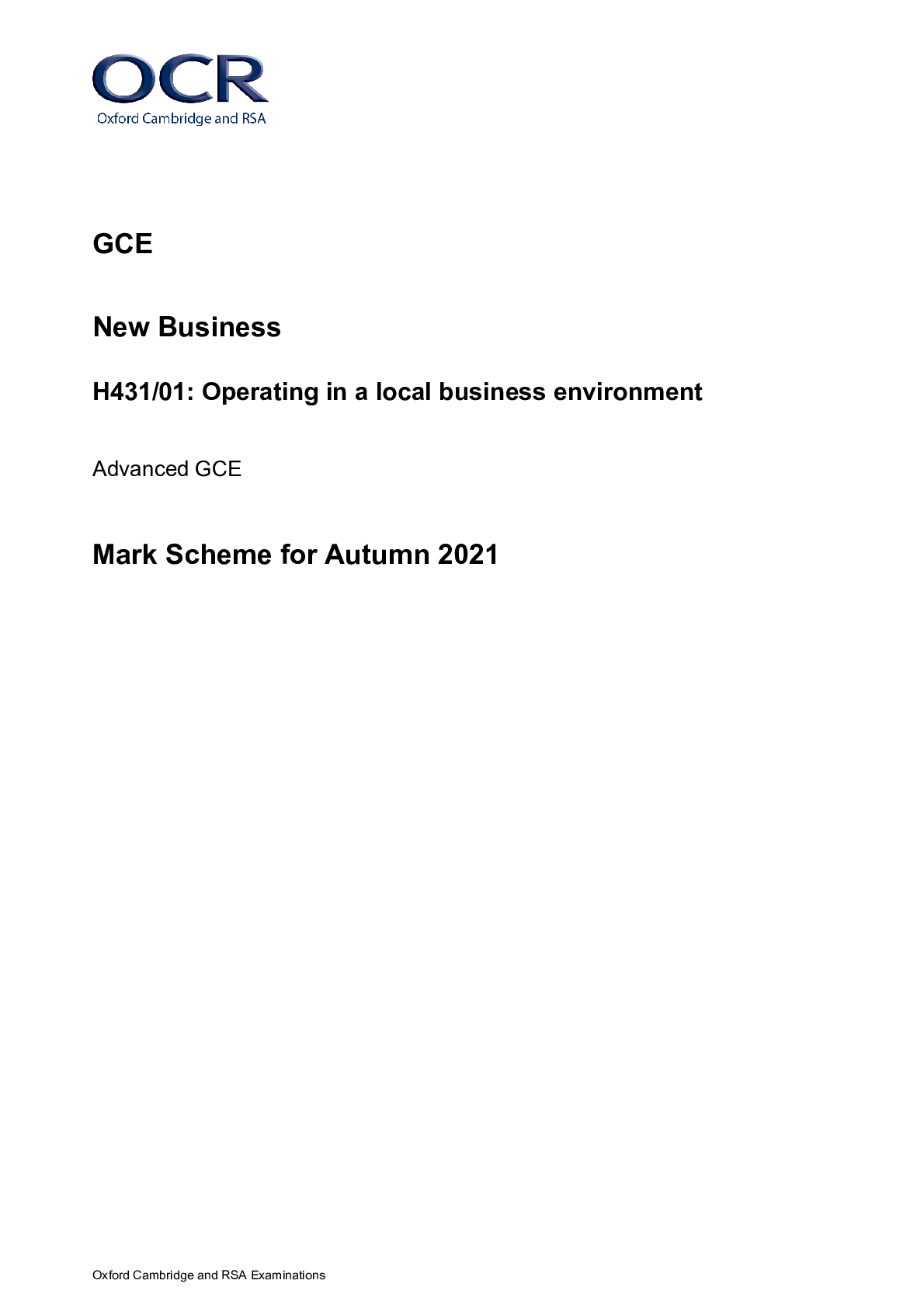
Reviews( 0 )
Document information
Connected school, study & course
About the document
Uploaded On
Oct 10, 2022
Number of pages
20
Written in
Additional information
This document has been written for:
Uploaded
Oct 10, 2022
Downloads
0
Views
40








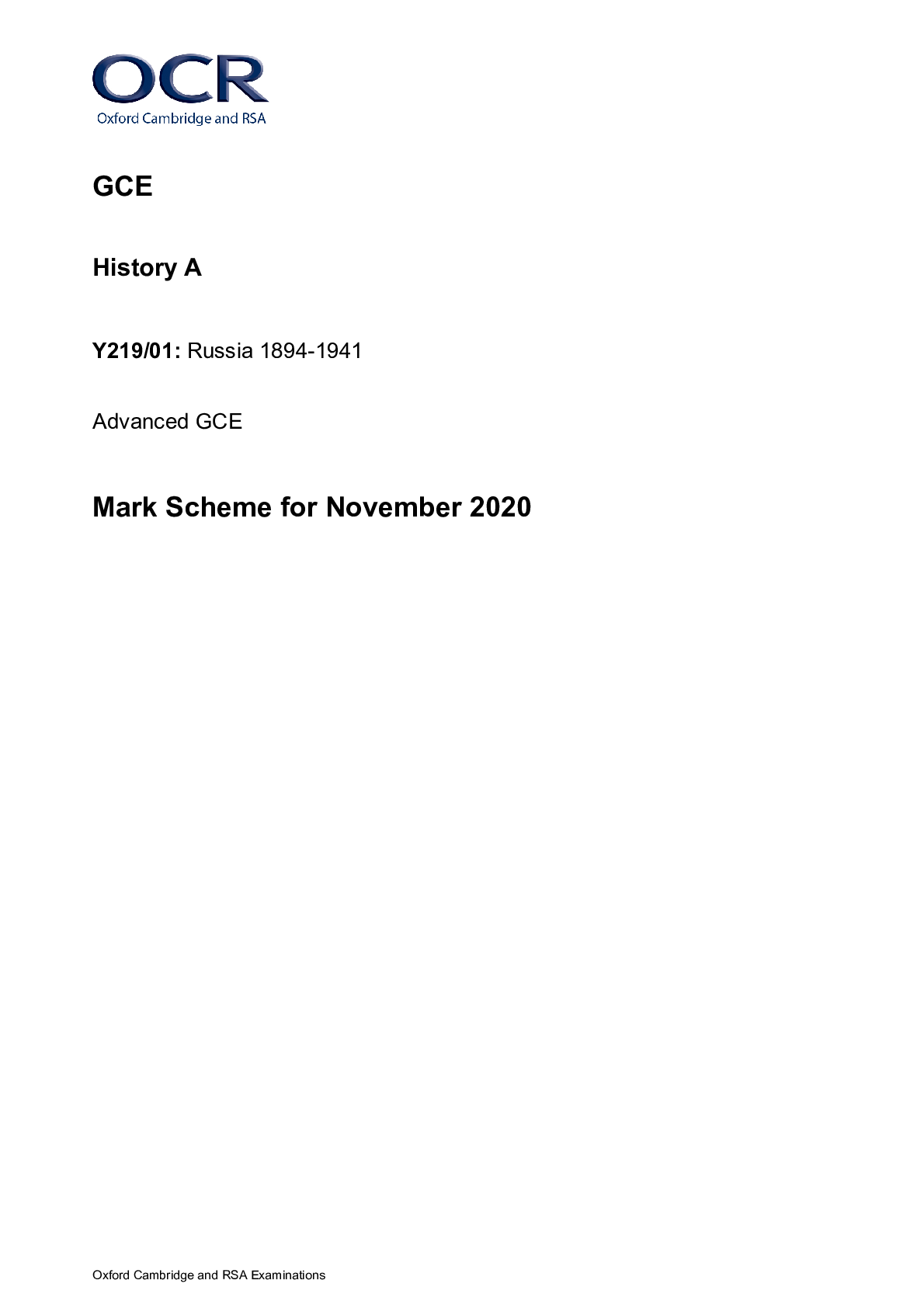
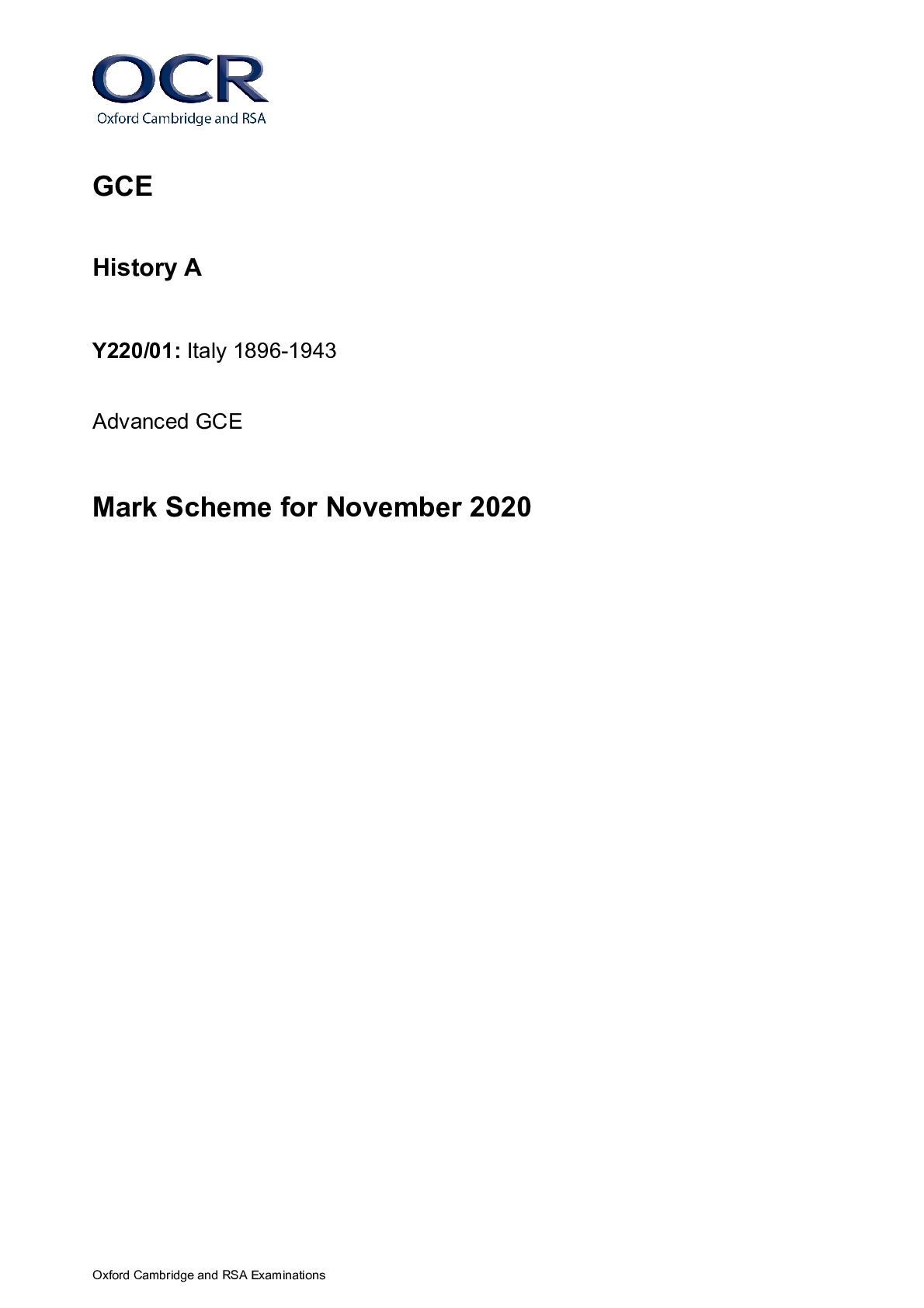

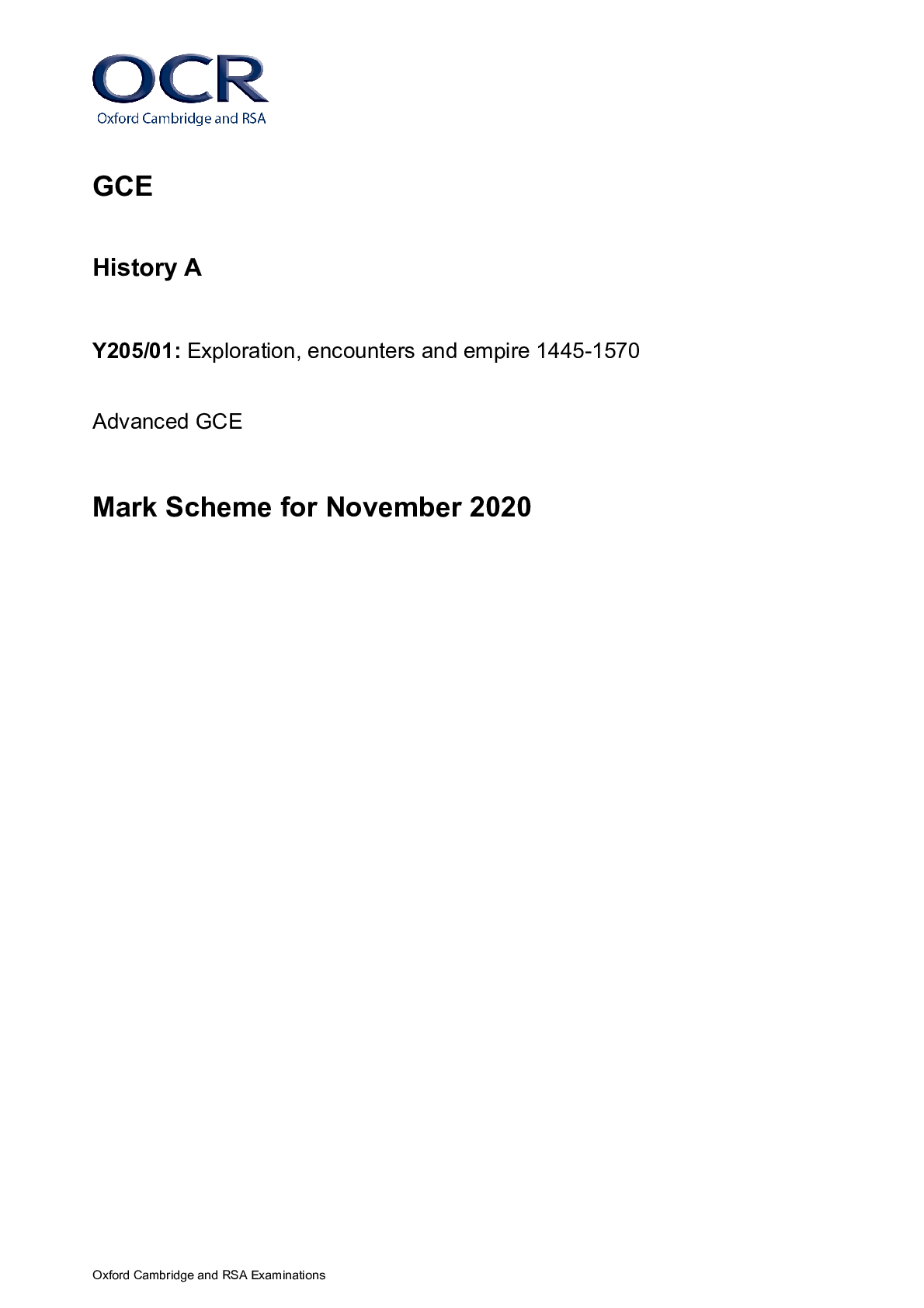
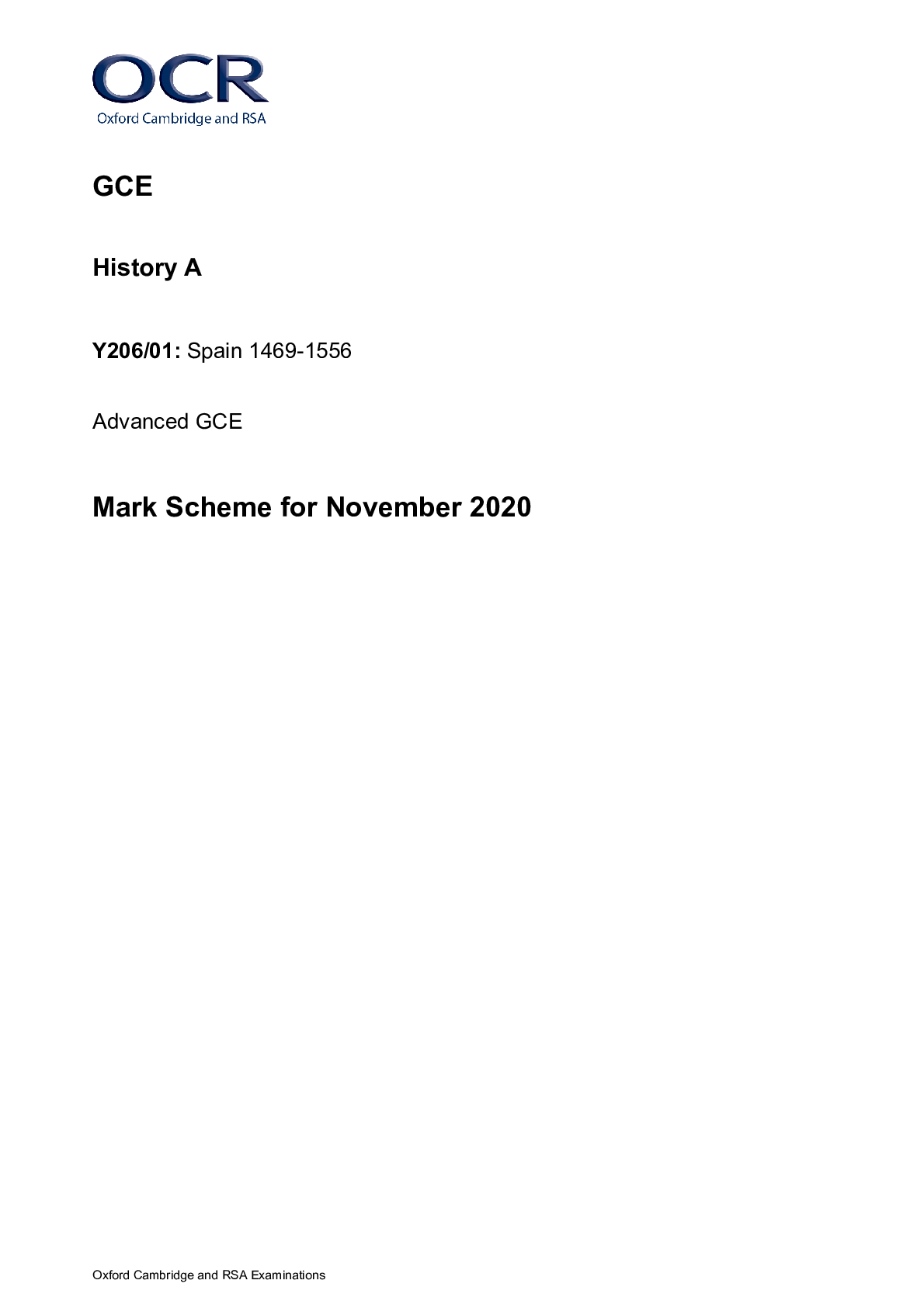
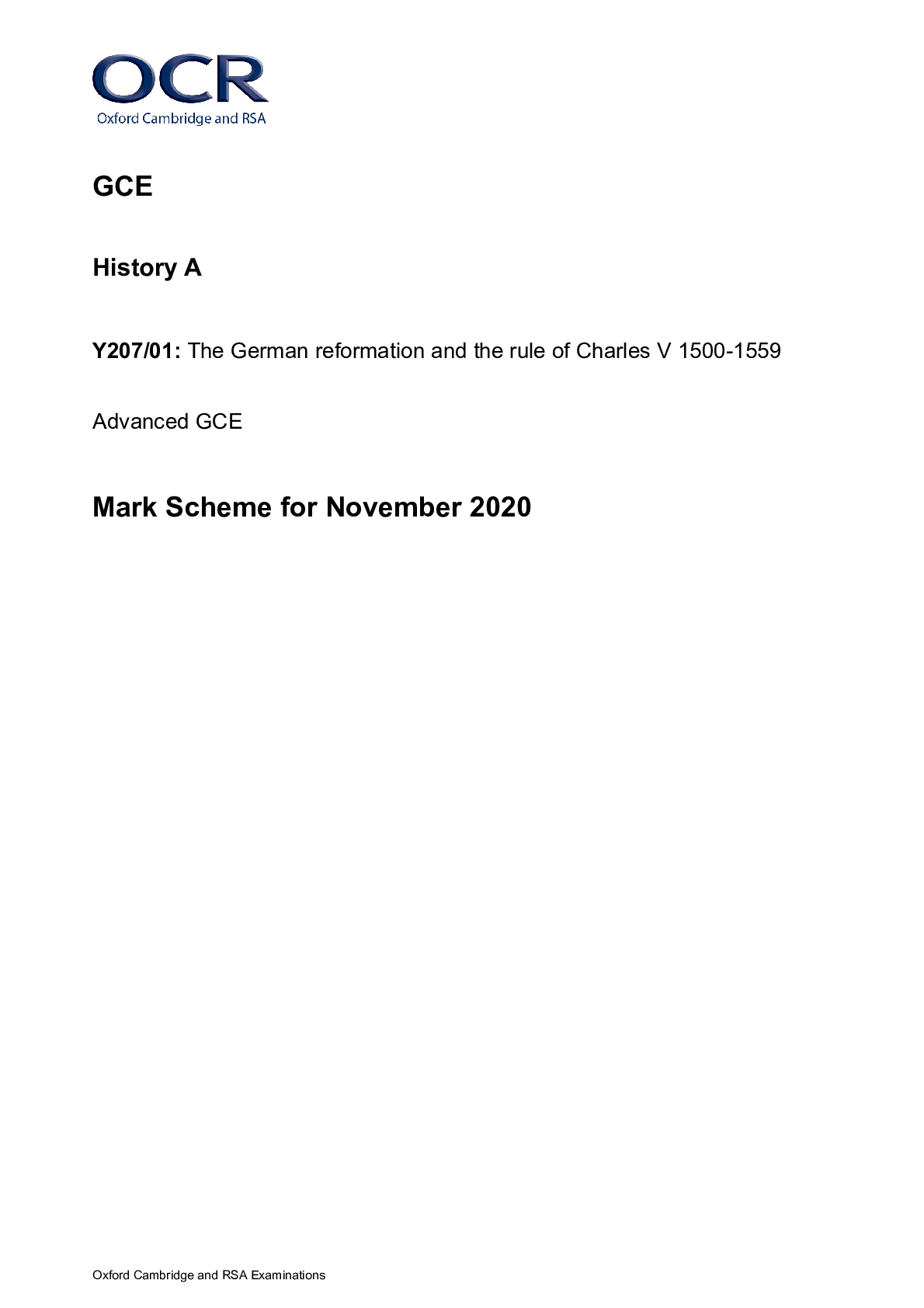
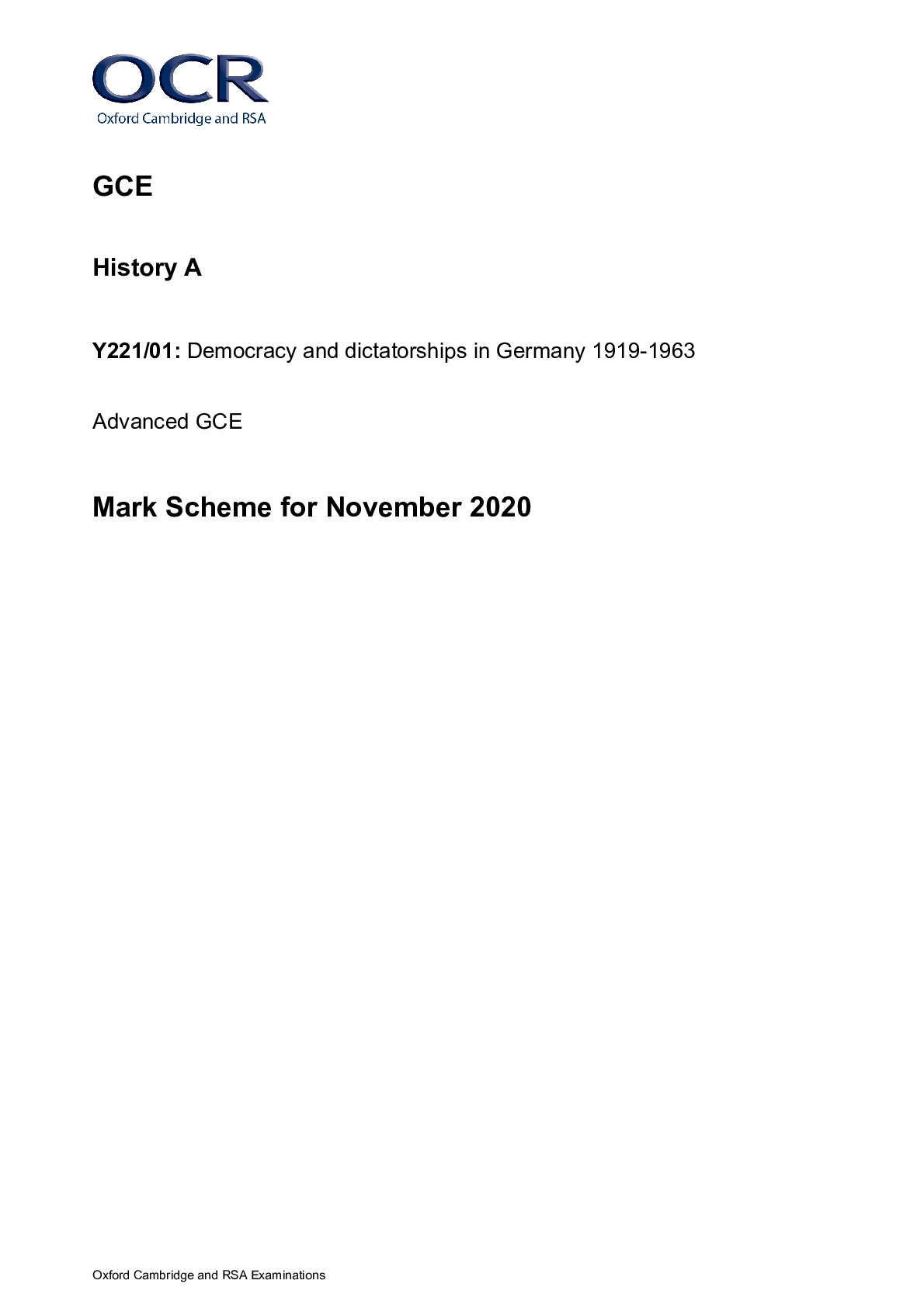

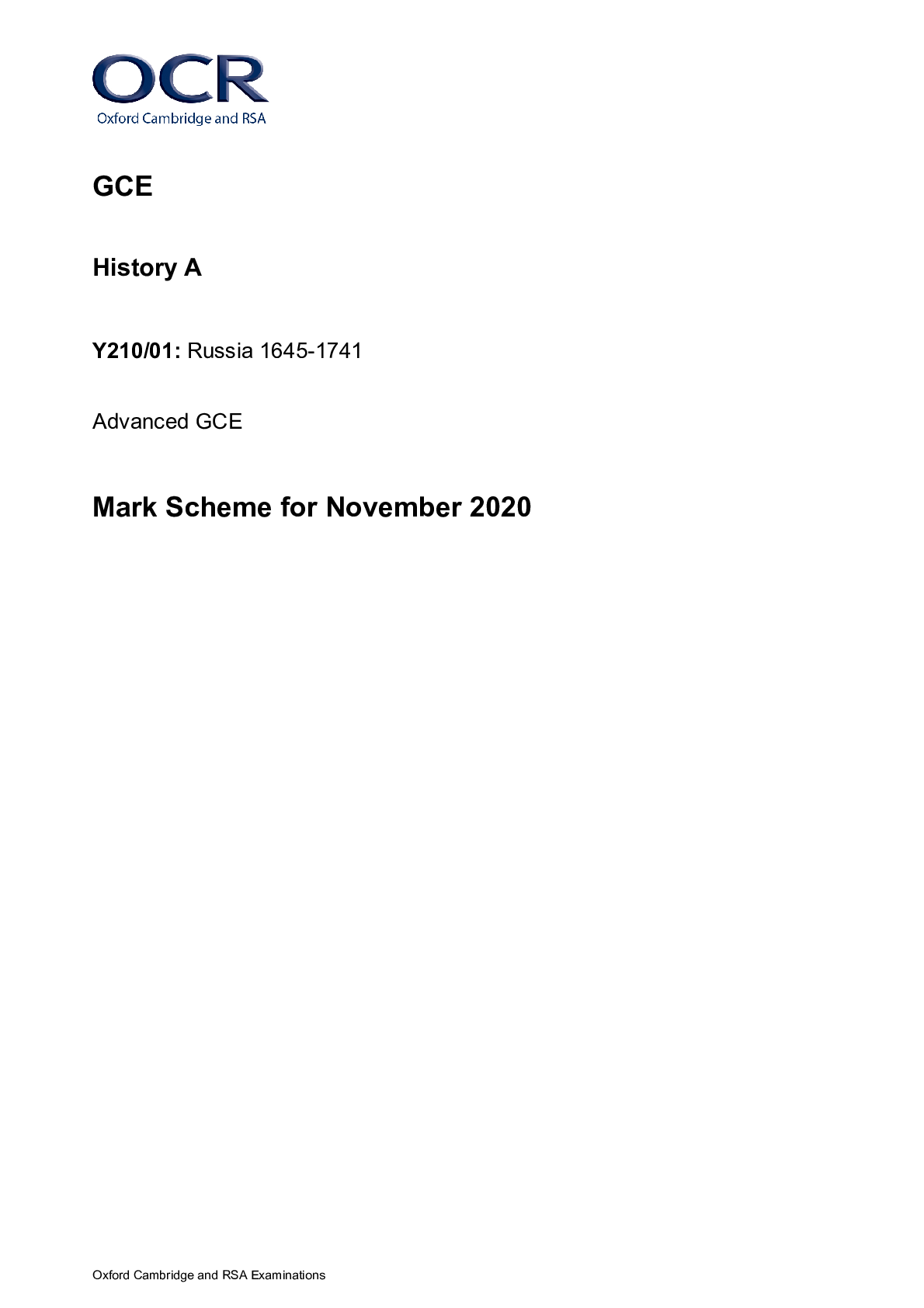


.png)






